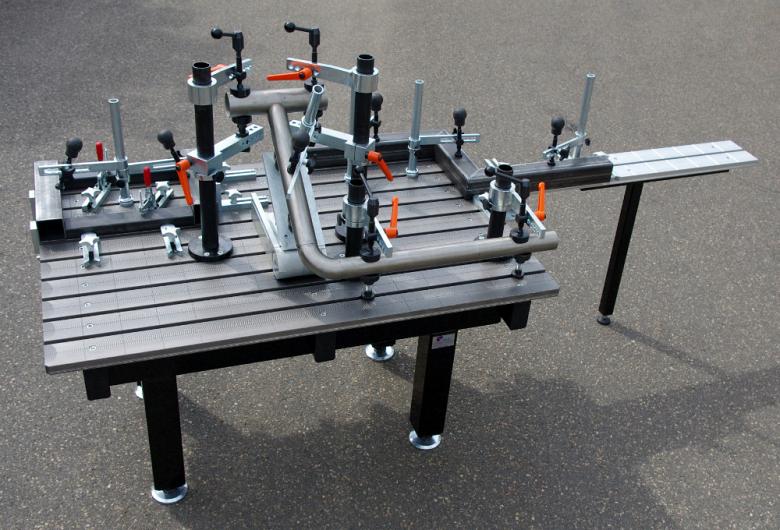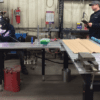How 3-D modular welding equipment improves working conditions and output
This article was originally published on and for TheFabricator.com by Michelle Howell of Forster America
Despite continued growth in the number of female welders, only 24 percent of today’s welders are women. Opportunities abound as employers struggle to find skilled welders. Advanced welding equipment, such as 3-D modular tables and clamping systems, can make welding a more attractive, feasible career option for females.
Photo courtesy of Förster America.
As long as females weld correctly and have the required certifications, they can achieve substantial success in the field. Nevertheless, according to the Precision Manufacturing Institute (PMI), which is accredited by the Accrediting Commission of Career Schools and Colleges, only about 24 percent of welders are women. While this is a significant increase from the less than 5 percent the PMI estimates were employed in 2016, it still leaves a lot of room for growth.
Only a small percentage of U.S. welders are females, largely because the industry is perceived to be suitable only for men. But the truth is, with innovative, cutting-edge equipment, the women welding alongside men are achieving the same high-tech standards as their male counterparts.
So, why aren’t more females applying for and getting welding jobs?
Why More Women Aren’t Welders
Historically, blue-collar jobs that involve manual labor have been dominated by men. Women, on the other hand, traditionally were employed in white-collar jobs, often in administrative positions, or as teachers, nurses, or seamstresses for two main reasons:
- Women generally stayed at home and looked after the household, while men were the breadwinners.
- Manual jobs, in general, were considered risky, if not downright dangerous.
Welding does come with dangers, not only from the risks associated with fumes, dust, and other pollutants in the air, but also because it involves working with electricity and gas, often in small spaces, at heights, and sometimes in water. Back and muscle strain also are concerns as welders have to bend and twist themselves into strange positions to reach hard-to-access areas.
While different welding jobs entail working with different types of equipment, the initial safety precautions for all welders, male or female, include proper training, wearing appropriate personal protective equipment (PPE), and using suitable ventilation systems.
Currently, the U.S. is facing a shortage of qualified people to fill welding jobs. In the 2017 IndustryWeek Salary Survey, welding was ranked as one of the jobs that is hardest to fill because so many industries require welders. This fact alone should help make welding a very attractive career option for anyone.
As is the case with male welders, the right skills and targeted experience increase the likelihood of females succeeding as welders. Providing them with appropriate training and high-tech, 3-D modular welding equipment can enhance the possibility for success and lead to higher salaries and increased career opportunities.
How 3-D Equipment Can Help Women Welders Succeed
For decades, designers have created ergonomic equipment for offices and homes, helping people avoid skeletal and muscular injuries by sitting correctly. High-tech welding equipment also enables those doing strenuous metalwork to maintain ergonomic positions and avoid injury.
Ergonomics combined with easy adjustments are key to top-quality welding equipment, particularly welding tables that can be modified to accommodate custom clamping and those that have lift and tilt or pivoting functions that operate with hydraulics.
Combined with various rotary tables, turntables, and lift tables, they simplify welding jobs, helping to make the process more efficient and, ultimately, faster.
If a welding table cannot be raised and lowered or adjusted to different positions, the welder might have to do the work manually on a static horizontal surface. To do this, she needs a certain degree of physical strength, as well as an ability to bend and literally contort her body to get to the exact points that need to be welded. But if welding equipment can be manipulated to make cutting, clamping, and joining the metal less likely to cause injury, the job can be done more quickly and downtime minimized.
With the right equipment, the welder doesn’t have to be strong, and there is absolutely no need to strain. This makes special welding tables and 3-D equipment particularly well-suited for use by females, but all welders benefit.
The optimal welding manipulator can be adjusted in height from about 2 ft. 7½ in. to 3 ft. 11¼ in., rotated by 360 degrees, and tilted to an angle up to 45 degrees. Both tilt and lift functions rely on hydraulics for movement, so the welder can change the table’s position without risking any strain.
Once the table is in the correct position, the workpiece can be clamped using a vacuum clamping system so that every bit of metal to be joined is easily accessible. Clamps also can be used with 3-D workpieces, which would otherwise be more challenging for anyone to weld.
So, whether you are a female welder or you employ them, there is a good case for using 3-D modular welding equipment. Not only is job setup easier and quicker, but the all-important bottom line is positively affected by improved efficiency.



